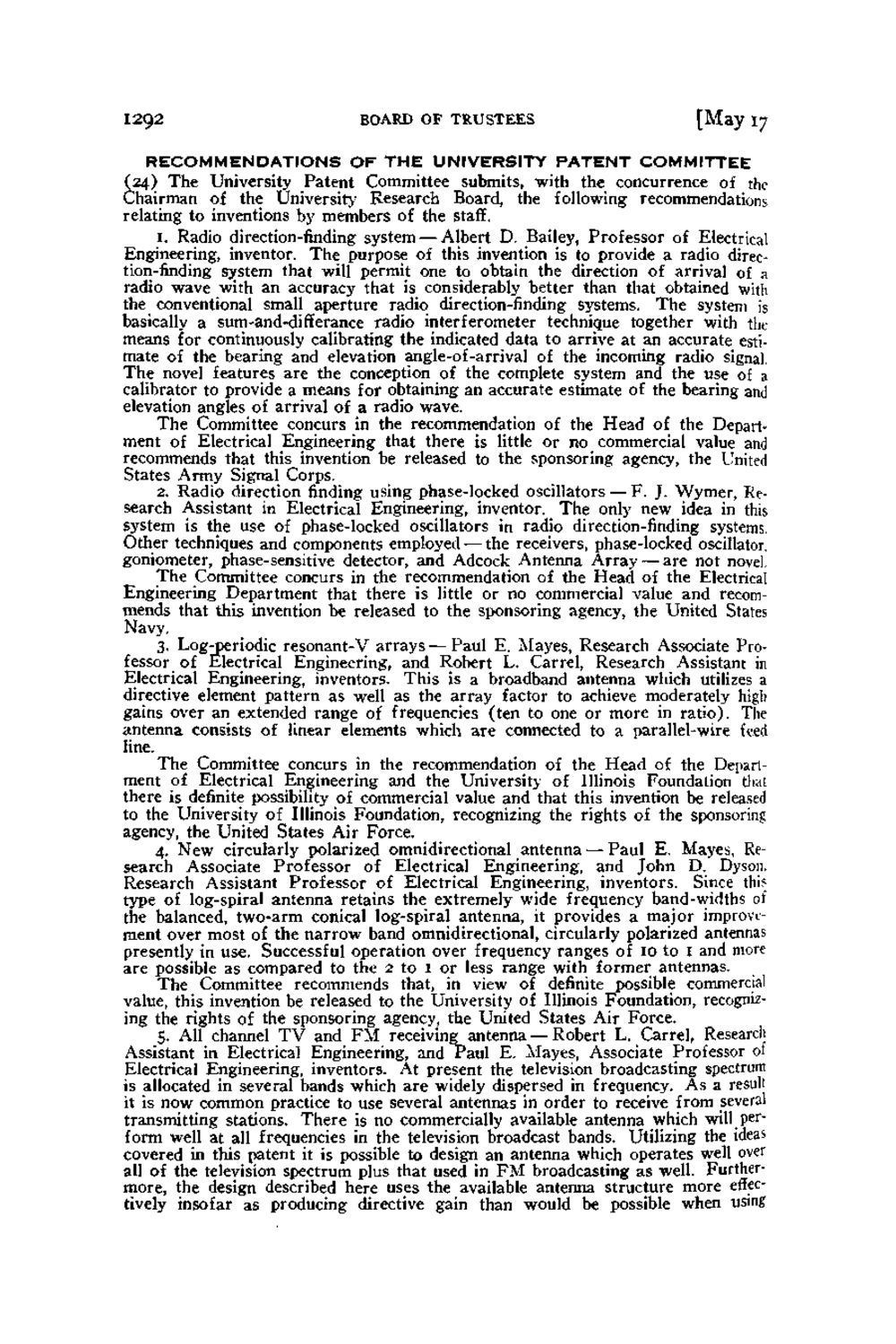| |
| |
Caption: Board of Trustees Minutes - 1960
This is a reduced-resolution page image for fast online browsing.

EXTRACTED TEXT FROM PAGE:
1292 BOARD OF TRUSTEES [May 17 RECOMMENDATIONS OF THE UNIVERSITY PATENT COMMITTEE (24) The University Patent Committee submits, with the concurrence of the Chairman of the University Research Board, the following recommendations relating to inventions by members of the staff. 1. Radio direction-finding system — Albert D. Bailey, Professor of Electrical Engineering, inventor. The purpose of this invention is to provide a radio direction-finding system that will permit one to obtain the direction of arrival of a radio wave with an accuracy that is considerably better than that obtained with the conventional small aperture radio direction-finding systems. The system is basically a sum-and-differance radio interferometer technique together with tinmeans for continuously calibrating the indicated data to arrive at an accurate estimate of the bearing and elevation angle-of-arrival of the incoming radio signal. T h e novel features are the conception of the complete system and the use of a calibrator to provide a means for obtaining an accurate estimate of the bearing and elevation angles of arrival of a radio wave. The Committee concurs in the recommendation of the Head of the Department of Electrical Engineering that there is little or no commercial value and recommends that this invention be released to the sponsoring agency, the United States Army Signal Corps. 2. Radio direction finding using phase-locked oscillators — F. J. Wymer, Research Assistant in Electrical Engineering, inventor. The only new idea in this system is the use of phase-locked oscillators in radio direction-finding systems. Other techniques and components employed — the receivers, phase-locked oscillator, goniometer, phase-sensitive detector, and Adcock Antenna Array — are not novel. The Committee concurs in the recommendation of the Head of the Electrical Engineering Department that there is little or no commercial value and recommends that this invention be released to the sponsoring agency, the United States Navy. 3. Log-periodic resonant-V arrays — Paul E. Mayes, Research Associate Professor of Electrical Engineering, and Robert L. Carrel, Research Assistant in Electrical Engineering, inventors. This is a broadband antenna which utilizes a directive element pattern as well as the array factor to achieve moderately high gains over an extended range of frequencies (ten to one or more in ratio). The antenna consists of linear elements which are connected to a parallel-wire feed line. The Committee concurs in the recommendation of the Head of the Department of Electrical Engineering and the University of Illinois Foundation that there is definite possibility of commercial value and that this invention be released to the University of Illinois Foundation, recognizing the rights of the sponsoring agency, the United States Air Force. 4. New circularly polarized omnidirectional antenna — Paul E. Mayes, Research Associate Professor of Electrical Engineering, and John D. Dyson. Research Assistant Professor of Electrical Engineering, inventors. Since this type of log-spiral antenna retains the extremely wide frequency band-widths of the balanced, two-arm conical log-spiral antenna, it provides a major improvement over most of the narrow band omnidirectional, circularly polarized antennas presently in use. Successful operation over frequency ranges of 10 to I and more are possible as compared to the 2 to 1 or less range with former antennas. The Committee recommends that, in view of definite possible commercial value, this invention be released to the University of Illinois Foundation, recognizing the rights of the sponsoring agency, the United States Air Force. 5. All channel T V and F M receiving antenna — Robert L. Carrel, Research Assistant in Electrical Engineering, and Paul E. Mayes, Associate Professor of Electrical Engineering, inventors. At present the television broadcasting spectrum is allocated in several bands which are widely dispersed in frequency. As a result it is now common practice to use several antennas in order to receive from several transmitting stations. There is no commercially available antenna which will perform well at all frequencies in the television broadcast bands. Utilizing the ideas covered in this patent it is possible to design an antenna which operates well over all of the television spectrum plus that used in F M broadcasting as well. Furthermore, the design described here uses the available antenna structure more effectively insofar as producing directive gain than would be possible when using
| |